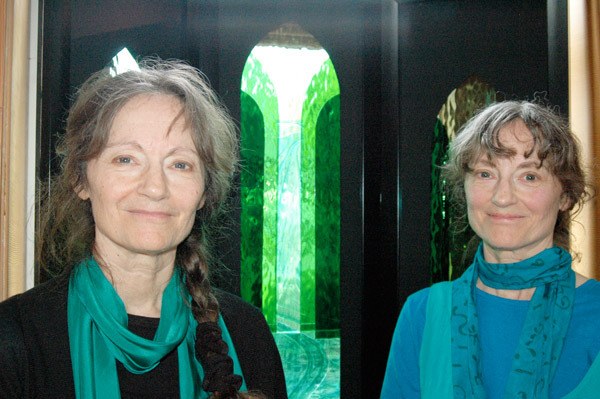Celebrating Our Watersheds
What: Artists’ reception
When: 11 a.m.-12:30 p.m., Saturday, April 23
Where: Quimper Unitarian Universalist Fellowship, 2333 San Juan Ave, Port Townsend
Cost: Free, refreshments served
As identical twins, Dianna Sarto and Deborah Harrison have a lot in common. From their graceful smiles and gentle sense of being to an acute awareness of nature and all its beauty.
After spending decades apart, a common love of old-growth forests and pristine waterways brought the sisters together. The sun of Sequim, yet its closeness to the shaded forests and freely flowing rivers resonated with both Sarto and Harrison. Their connection with the area sparked while camping along the Elwha River in late 2014.
“I’ve never seen her that happy since we were 8 years old,” Harrison said about her sister while reminiscing on their time along the river.
There, Harrison watched salmon slap the water as they made their life journey to spawn and together the sisters found pure joy and happiness in its most raw form.
“We found out about the dams coming down and we were so inspired that the river was set free,” Harrison said.
The story of Elwha River dam removal and the achievement of doing something that seemed impossible for so long “gave us hope,” Sarto said.
“I felt it was a symbol and a sign of what needs to happen for the healing of our planet and our culture,” Harrison said.
Since their time on the shores of the Elwha River, Sarto and Harrison have journeyed along many of the Olympic Peninsula’s wild rivers, such as the Dungeness and Hoh rivers, as well as the Ohanapecosh River near Mount Rainier. Exploring, experiencing and being with the rivers only deepened their love and appreciation for water as something sacred.
“What we mean by the preciousness and sacredness of water is the power of water,” Sarto said. “Especially clean water to restore, renew and regenerate life.”
Water as art
Turning to their natural form of expression, the twins created an art exhibit in hopes of sharing the local watersheds and the joy they’ve brought both Sarto and Harrison. The exhibit “Celebrating Our Watersheds” opens with an artists’ reception Saturday, April 23 in honor of Earth Day.
“We feel such a connection with the earth that for us Earth Day is one of the most meaningful days set aside,” Harrison said.
Through their art recognizing the watersheds, the twins aim to inspire people to visit the rivers and open themselves up to experiencing and connecting with nature and potentially inspire action.
“It’s about shifting consciousness,” Harrison said. “As the world around us suffers from increasing droughts, wildfires and water pollution, the preciousness of clean abundant water is increasingly apparent.”
Despite their identical outward appearance, in the exhibit both artists reflect the sacredness of water in their own unique ways.
Sarto applied her formal education and background as a painter to photography in her “Riverwalker Series.”
“This series began as photographs of my own shadow on sunlit water as my sister and I walked along of the most beautiful rivers of the Pacific Northwest,” she said.
Sarto drew on her connection with the light captured in each of the photographs to digitally refine the compositions and enhance the colors.
“I am hoping the images convey the feeling that we are made of water and the resonance with water,” she said. “It’s the water, but also the sunlight coming through the water and the beauty of that and seeing my own figure disappear as that light comes through … It just helped with me opening up and realizing that if I can get the ego or the person out of the way, the beauty comes through the elements.”
Although artistic as a child, Harrison didn’t pursue art like her sister. Instead, discovering or perhaps uncovering her artistic vision has been a more recent journey spurred by a dream.
“I was at a junction in my life where I wasn’t sure what I should be doing and a dream came to me of the ‘watersculpture’ and I just sensed deeply that it wanted to come into the material plane,” Harrison said. “I didn’t know how to do that so I just started taking ceramic classes.”
The basic design of the fountain that came in a dream eventually became Harrison’s first watersculpture. Since, she said, different designs have evolved.
The watersculptures are handcrafted from stone, glass and ceramic, featuring flowing water as their central element. The watersculptures are created using sacred geometry, which are specific geometric shapes long considered reflective of creation’s “energetic blueprint,” Harrison said.
The shapes include the circle, square, equilateral triangle and spiral.
“My intention in creating these watersculptures is threefold: to bring harmony to a physical space, to invite the quieting of spirit that is needed to access one’s inner guidance, clarity and tranquility, and to awaken in the viewer a sense of sacred, both within and without,” Harrison said.
The twins combine their creative interpretation of water in a collaborative project Waterglass Altar I, a three-paneled layered glass art piece.
“Doing the piece together was an adventure because it was a very difficult piece to do,” Harrison said.
The altar was created by layering a material known as water glass and uses Gothic abstract forms to evoke a sense of the sacred, explained the sisters. The shapes and translucent hues of the water glass depict a watershed with a stream coming from an unseen source, spilling down a mountainside to renew the land, reflected as green forests.
“Water is life — water is where life begins and it sustains life,” Sarto said. “I think that was the feeling behind this piece and water’s central role in renewing, restoring and regenerating life. We wanted to bring that into focus.”
Reach Alana Linderoth at alinderoth@sequimgazette.com.



